Last Updated on August 19, 2025
Reusing your items is one of the best things you can do for the environment. As well as simply using what you have!
Before buying new, I’ll borrow from a loved one first. If that doesn’t work, getting it secondhand is second best. And, as a last resort, I’ll buy it new – but support small businesses where applicable.
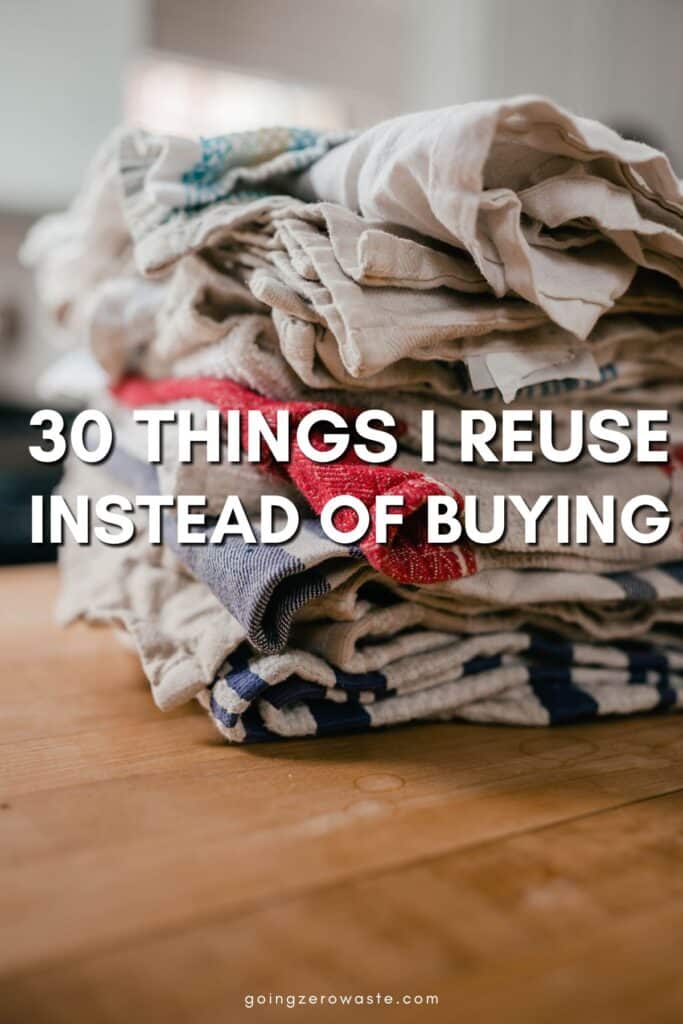
Some of the links in this post are affiliate links; for more information please see my disclosure policy.
There’s already so many items on this planet – and our resources aren’t infinite. Did you know every single piece of plastic ever made still exists today? Considering most items are made from plastic nowadays, we should make the effort to buy less and choose well.
If you’re looking for a list of items that you can reuse over and over again, here’s what I love to use.
This post is divided into sections to make it easier to navigate, so feel free to jump around where you need to. I also tried to link to small businesses whenever possible in place of Amazon.
kitchen
The kitchen is one of the most wasteful rooms of the home. And I spend a good chunk of time in it whipping up scrappy recipes (check them out in my new book, 101 Tips For a Zero Waste Kitchen)!
1. reusable water bottle
Almost everyone has a reusable water bottle nowadays, which is great! But I’ve noticed that sometimes people feel pressured to buy these to be trendy (ahem, Stanley cups anyone?).
Now those very Stanley cups are littering thrift stores. My best advice? Stick to what you have.
And if you are in need of a new reusable water bottle, I’ve had my Klean Kanteen for 6 years and couldn’t be happier with it!
2. tumbler
If you love hitting up cafes for tea or coffee, consider bringing a reusable tumbler with you! I’ve even been known to bring a coffee mug from home in the past if I plan to stay for a bit.
Of course, double check the cafe doesn’t offer their own mugs if you order it to stay. Many small, local cafes will!
3. french press
I cannot say enough about my French press – yes, it can make coffee. But it also can make loose leaf tea! And we love a versatile, reusable product that eliminates the need for single-use K-cups or plastic tea bags.
4. stasher bags
To replace plastic ziplock bags, I recommend silicone bags that seal shut. Stasher bags are a good option to consider. You can use them in the microwave, freezer, or even the oven.
5. metal lunch box
A metal lunch box totally beats wrapping a sandwich in plastic wrap or aluminum foil. They even have tiered ones which are great when you want to pack more than one thing but don’t want the foods touching. You can wash and reuse it for years to come.
6. snapware
Glass snapware is perfect for storing leftovers, cut produce, and transporting homemade goodies! You don’t have to worry about plastic leaching into your food either. And it can be frozen too, if need be.
7. silicone baking mat
I love lining my pans with a silicone baking mat – I use it in place of parchment paper or tin foil and it works like a charm. Just clean and repeat! Use some baking soda and a wooden scrubber to get off burnt-on grime.
8. silicone covers
Silicone bowl covers work great at covering bowls with leftovers instead of using plastic wrap. I don’t prefer beeswax wraps (though that is another option).
9. long handled wood dish brush
Instead of a sponge, which can get grody very fast, consider switching to a long handle wooden dish brush! Not only will it make cleaning easier, it helps reduce plastic waste.
And, you only have to change out the top part of it periodically – which can be composted. I like to use it in tandem with a dish soap block, but refillable liquid soap is a great option too.
10. rechargeable candle lighter
Instead of single-use matches, try switching to a reusable candle lighter. You can recharge it, so it can be reused indefinitely! Saves you money in the long run. Pair it with some sustainable, non-toxic candles!
11. cloth napkins
I’m never purchasing single-use napkins again. Reusable cloth napkins save SO much money, and when you’re done, just chuck them in the washing machine! There are so many cute ones you can invest in with a multitude of patterns to fit any vibe.

cleaning
There’s a lot of waste that comes with cleaning (paper towels, wipes, harsh chemicals etc.). But there doesn’t have to be!
12. reusable cloth towels
Instead of paper towels, try using reusable cloth towels to clean messes. This can be rags (from old t-shirts or sheets) or microfiber cloths.
Just chuck them into the laundry bin when you’re done. And yes – you can use these to clean toilets too! Make sure to keep a color coded system going.
13. swedish dish cloths
Swedish dish cloths are great for cleaning countertops – and they’re reusable for a long time. Think of them like a reusable paper towel. Just add water, some soap, and you can use them to clean surfaces. Or soak up spills.
They can even be washed (just air dry them). When they reach the end of their life, just cut them up and add them to your compost!
14. reusable swiffer pads
If you still have a swiffer pad, don’t toss it. Just get reusable swiffer pads! When yours starts to look grimy, toss it in the wash. No waste needed! If you’re good at sewing, you can probably even make your own.
15. washable duster
I have a plastic-free feather duster I purchased secondhand made from ostrich feathers and a wooden handle. It gets the job done and I don’t need to waste any disposable wipes or paper towels.
16. refillable cleaning products
Instead of buying a new bottle of cleaner every month, why not reuse the same container and just refill it? Many sustainable cleaning companies offer refills that reduce so much plastic waste.
Blueland is a good example of this – nab their spray bottles once, then refill it using their condensed, water-activated refills. Here are some more sustainable cleaning options. And I also love DIY cleaning products too – as long as it’s not laundry detergent!
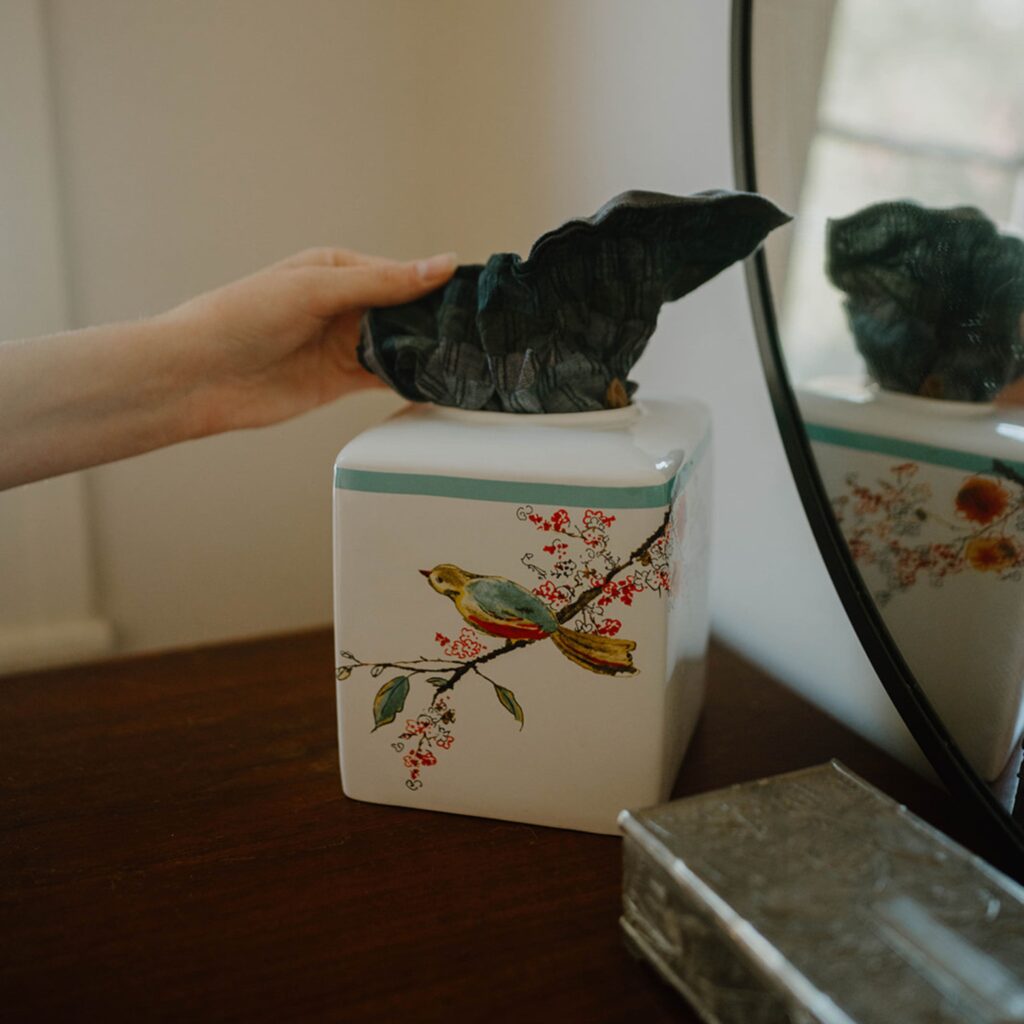
bathroom and personal care
The bathroom is an area where a lot of waste gets generated. It’s probably the second most wasteful room in the home after the kitchen.
Makeup, skincare, and haircare products can also be extremely wasteful. Especially if you like to keep up with trends, or get those ‘restock’ videos on your feed.
FYI – those videos aren’t normal and are usually beauty influencers who receive tons of PR (no average person could go through THAT much product, even in one year’s time).
17. reusable cotton rounds
Instead of disposable cotton rounds, I made my own reusable cotton rounds from scrap fabric! I had a flannel shirt that shrunk and didn’t want to toss it – so I upcycled it instead. I can reuse these cotton rounds over and over, which I love. I use them to remove makeup or apply toner to my skin.
18. bidet attachment
I don’t use toilet paper wrapped in plastic (I’ve switched to Who Gives a Crap), but I barely even need TP because of my bidet! It’s easy to install a bidet on your toilet (yes, they even have ones for renters).
Tushy is one option, but there are many bidet brands out there worth checking out. Bidets can be used to clean more than just number two – they’re great for post-sex and workouts, and that time of the month (ladies, just lean forward a little bit). They’ll keep you clean in so many ways!
19. refillable soap
Instead of using hand soap you dispose of after it empties, consider switching to a container you can refill. Head to a local refillery (if you have one), or buy from a brand that offers refillable hand soap options.
The same applies to shampoo, conditioner, and body wash soap too! There are several brands that make refillable products you can use in the bathroom. Plaine Products, Public Goods, and Blueland are just a few options to consider. You can also use bar soap.
20. handkerchiefs
I’ve stopped using tissues and switched over to handkerchiefs instead, which can be washed after use. I fold them in an accordion pattern so when you pull one, it’ll automatically pull the next one out.
I store them in an old porcelain cover box. Many of them are from my grandmother and great grandmother, which is a lovely way of keeping them with me.
21. reusable period products
In the U.S. alone, around 12 billion pads and 7 billion tampons are thrown out every year. Switching to reusable period underwear is a great way to reduce period waste.
I co-founded a period underwear company (Kayaness) with my best friend, Shelby, so I’m a little biased!
But period underwear are wonderful for those irritated by period pads and tampons and want to feel like they’re wearing nothing. Use the discount code kay10 for $10 off your first order!
But reusable pads and menstrual cups are also options for those who prefer extra coverage. Menstrual cups may take some trial and error to find the right fit – but once you do, it will keep for hours!
22. safety razor
Disposable razors don’t work well and rack up in cash. But when you buy a safety razor, it’s not something you’ll have to replace for years (if ever).
All you’ll need to do is replace the razor blades – but those can be recycled. And honestly, I bought a pack of refills back in 2017 that I’m still using – it will probably last me for several more years, seeing as they don’t have to be replaced frequently.
23. glass nail file
Most nail files are flimsy and break after a few uses. However, I absolutely love my reusable glass nail file because I can just wash it clean when I’m done and reuse it without worrying it will break!
24. refillable makeup products
There are so many amazing eco makeup brands making a conscious effort to package their products thoughtfully. I am a huge fan of Kjaer Weis and Zao because they are refillable and made using natural ingredients.
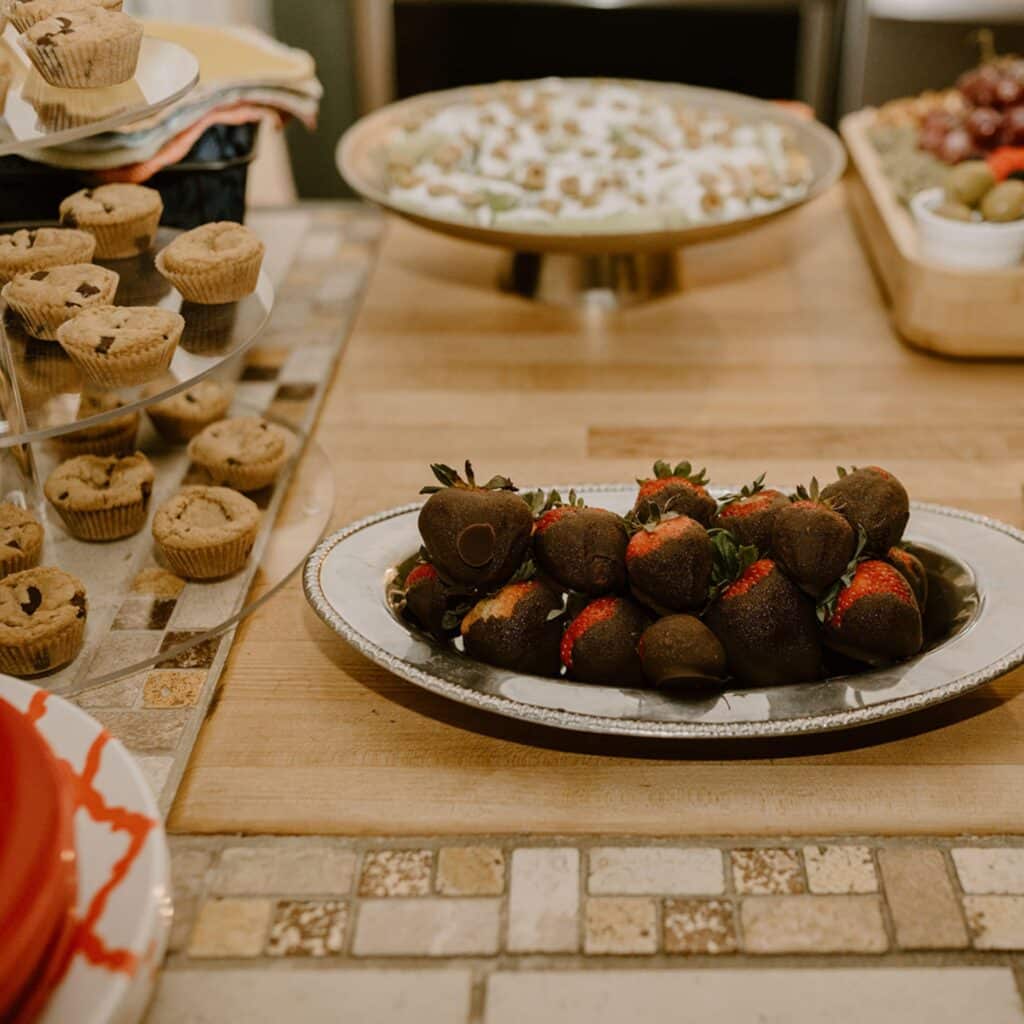
parties and events
Parties can create a large amount of waste, from the food to the decor. But with a little planning, you can prevent this (and still have fun!).
25. reusable plates and cups
Having a stash of plates you keep just for parties is a great idea. Hitting up a thrift shop will deliver affordable results. At the end of the night, ask your friends for help to load up the dishwasher!
For drinks, obviously you can just use glass cups if it’s a dinner party. But if you know guests will be wandering around and may be drinking alcohol, investing in stainless steel pint cups might be for the best. Another option is asking friends to bring their own reusable tumblers!
26. reusable silicone baking cups
If you’re planning on baking for a gathering, especially muffins or cupcakes, consider investing in reusable silicone baking cups! They will save you money, plus you can just wash them for next time (they’re freezer and dishwasher safe too – a plus!).
27. fabric gift wrap
I love wrapping gifts with furoshiki wrap (aka cloth/fabric). You can thrift pretty scarves, sheets and handkerchiefs you use as wraps but make a second gift!
But you can also upcycle gift bags and tissue paper, reusing them over and over again. Reusing packaging paper to wrap your gifts is also charming (keep it plastic-free by tying it together using twine).

office and stationary
28. refillable fountain pen
If you work an office job, you probably go through a lot of pens. But switching to a refillable fountain pen will save you money in the long run! I draw the ink from an ink well.
And if you’re worried you might lose it – when you know an item is valuable, you’re going to treat it a lot better. Plus there are lots of carrying cases you can nab for it on the go.
29. wooden highlighters
Are you constantly highlighting things in college textbooks or in books? Consider switching to wooden highlighters. They don’t bleed through the paper and are completely plastic-free. And yes, reusable, to the last point! They won’t dry out on you either.
30. rechargeable batteries
Switching to rechargeable batteries is such a great way to reduce e-waste, but also saves money in the long run. You won’t constantly be tossing out batteries and can just put them on a charging dock when their juice runs low.
What do you think of these reusable products? Which is your favorite, or what would you add to this list? Let me know in the comments!
The post 30 Things I Reuse Instead of Buying New appeared first on Going Zero Waste.
Green Living
6 Best Non Toxic Diapers For Babies
Last Updated on October 15, 2025
Did you know the average newborn goes through 10-12 diapers per day? That’s a lot of waste – and a lot of time spent in diapers.
Most babies have more sensitive skin than adults, as their skin hasn’t fully developed yet. The protective hydrolipidic film is still very thin, which makes infant skin more vulnerable to harsh external factors.

Some of the links in this post are affiliate links; for more information please see my disclosure policy.
Those external factors include diapers. Babies spend a lot of time getting in (and out) of them. So it’s important to choose non toxic diapers that are gentle on both skin and planet. Here are the best non toxic diapers on the market.
which diapers are the least toxic?
The diapers that are least toxic include ones made from plant-based or cotton materials. Look for brands that omit harsh chemicals like chlorine, phthalates, and PFAs.
Many diaper components are made up of plastic, which is hard to avoid in the name of efficiency.
That being said, it’s best to choose diapers from brands that minimize the amount of plastic in their products. Plastic materials can emit VOCs known to harm health.
Here are some general guidelines to adhere to when choosing diapers:
- Choose diapers that disclose the ingredients (some don’t!). Avoid anything with fragrance, lotion, or other skin-conditioning adhesives.
- Look for brands that minimize the amount of plastic in their products.
- Consider cloth diapers, ideally made from organic cotton.
- Opt for brands that use unbleached pulp or pulp bleached without chlorine
- Try to choose plain, undyed diapers with minimal designs (dyes can be contaminated with toxic heavy metals).
- Check for certifications like Forest Stewardship Council or EWG certified.
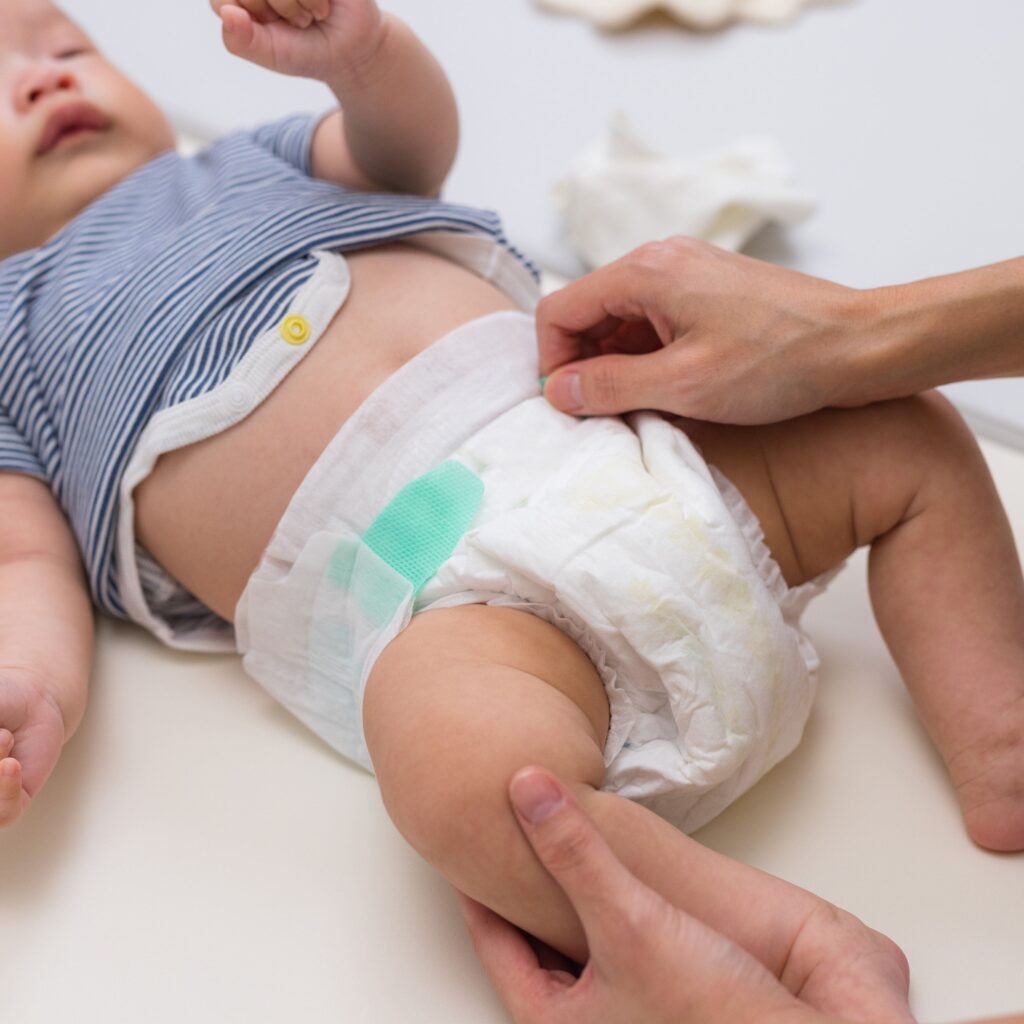
is Huggies or Pampers less toxic?
In terms of being less toxic, Huggies has stated all of their diapers are free of fragrances, phthalates, parabens, and elemental chlorine. They’ve also partnered with Terracycle to offer plastic film recycling options.
Pampers diapers are made without parabens, natural rubber latex and elemental chlorine. But only their Pure diapers are made without fragrance (and many mothers online have complained of Pampers’ strong scent).
However, Pampers’ factories are zero manufacturing waste to landfill and they use FSC certified wood pulp.
Both brands list their ingredients on their websites, so definitely read them for yourself before making a purchase. Just be mindful both brands also use colorants and printing inks to make designs and/or color change technology.
which diaper brands are safe for babies?
The diaper brands safe for babies are listed below. There’s a mix of disposable and cloth diapers, so there’s something for everyone.
However, be mindful that every baby is different and what works for one, doesn’t always work for another. For example, certain brands may fit your baby like a glove, whereas others may be too big: It’s all about experimenting and finding what works for your baby.
You can use this list as a starting point to help you choose a better, safer choice for your child. None of the brands listed here use fragrance, parabens, or other harsh chemicals.
I’ve gone ahead and highlighted some of my favorite features of each brand, but it isn’t an exhaustive list. Be sure to check out their websites for more information.
Also, if you cloth diaper, don’t forget to consider eco-friendly baby detergent brands because you’ll be doing a bit more laundry!
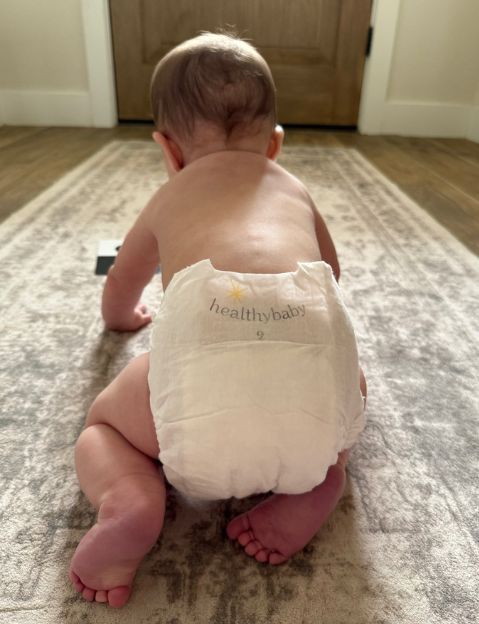
1. healthy baby
- Offers disposable and cloth diapering options
- Six sizes, not including newborn (N or N/1)
- Plant-based materials including organic cotton + FSC certified pulp
- 12 hour leak protection
- No chemical wetness indicator
- EWG certified
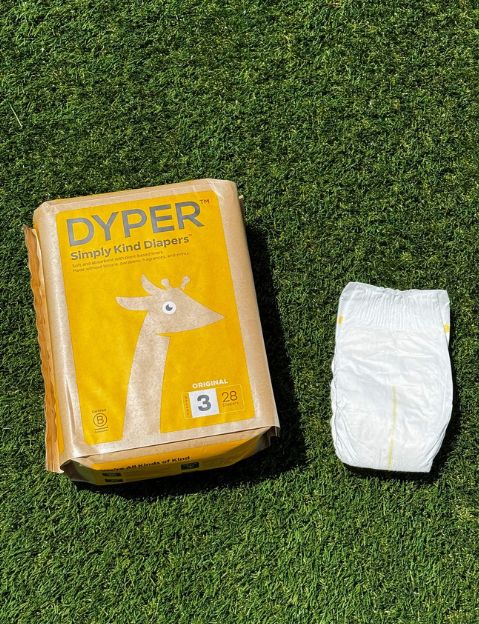
2. dyper
- Disposable diapers
- Six sizes, not including newborn (NB)
- Plant-based materials, including FSC-certified pulp
- 12-hour leak protection
- No inks, prints or dyes
- Offers REDYPER service to compost diapers through weekly pickup
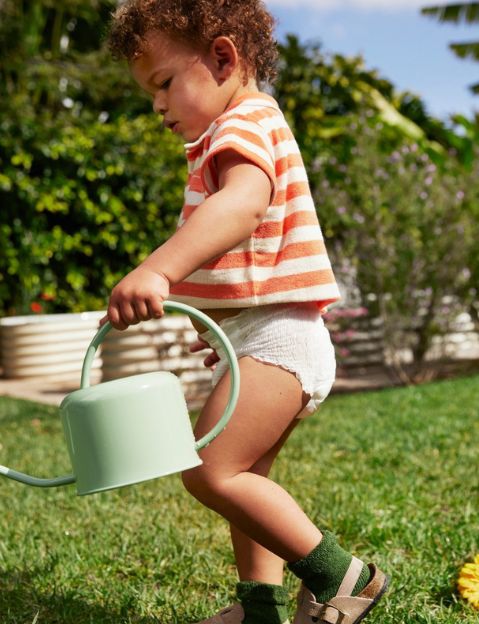
3. coterie
- Disposable diapers
- Seven sizes, not including newborn (N or N+1)
- 25% plant-based, made with wood pulp from sustainably manages forests
- 12-hour leak protection
- Wetness indicator
- Cruelty-free
- OEKO-TEX STANDARD 100 Certified
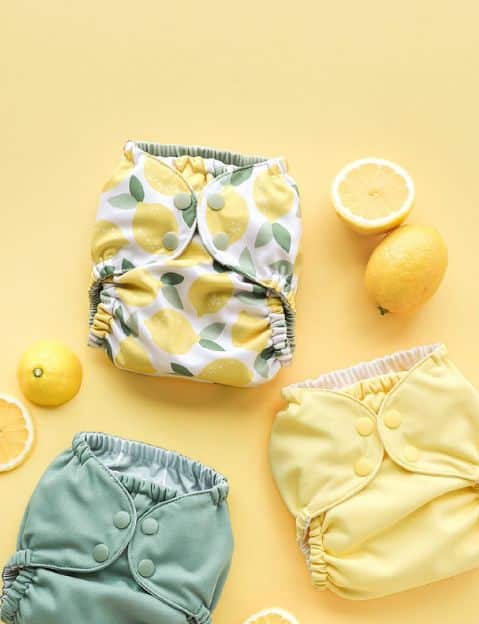
4. esembly baby
- Cloth diapers
- Two sizes, based on pounds
- Made of organic cotton + upcycled TPU
- Recommended to change an awake baby every 2-3 hours
- Wet bags sold separately to hold dirty diapers while out
- Pre-loved options to buy and sell available
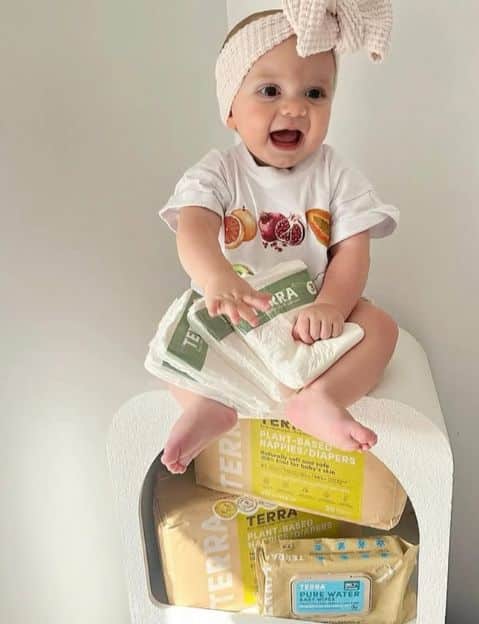
5. terra
- Disposable diapers
- Six sizes
- 85% plant-based, including FSC-certified pulp
- 12-hour leak-proof protection
- Plant-based wetness indicator
- Ink on product + packaging is food grade
- Packaging is made from recyclable kraft paper + rice
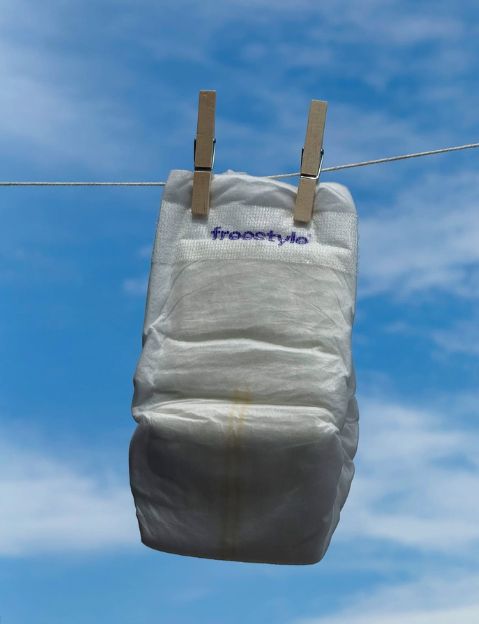
6. freestyle
- Disposable diapers
- Six sizes
- 7-layer protection for 14x better absorption
- Delivered in 1 month long supplies
- FSC certified pulp
- EWG verified
Which of these sustainable diaper options would you choose? Let me know in the comments!
The post 6 Best Non Toxic Diapers For Babies appeared first on Going Zero Waste.
Green Living
The Many Layers of Personal Style
Personal style is a dance between dualities: fashion as art and fashion as function; clothing as self-expression and clothing for our circumstances.
Style is a medium for communication and self-expression, yes. But it’s also shaped by the environments and requirements around us, from workplace dress codes to city cultures, climates, and specific occassions.
In last Saturday’s workshop, where we talked about how to remix what you already have in your closet, attendees shared a common challenge:
How do you balance your personal style expression while dressing for the various situations and environments we operate in?
“I’ve found above all else my style is highly influenced by my environment (my job, my city etc.)—sometimes it becomes about ‘fitting in’ and losing individuality”
“I find I’m too led by my day-to-day lifestyle. I WFH and so often I just don’t get dressed at all.”
“There are too many applications: workout, work, at home, formal occasion.”
Style as Identity vs. Style as Communication
It’s no wonder style and getting dressed can feel so confusing.
In the personal style world, we learn to dress for who we are on the inside. And then we see the style rules in fashion media: here’s how to dress for this season, this dress code, this city.
And in our real lives, we have real dress codes we might have to follow, whether for a workplace or a wedding.
But what if all those sides conflict?
- If my style words are “casual” or “sporty” but I’m in a workplace 40+ hours a week that requires business formal, where does that leave my personal style?
- If I love vibrant and artsy looks, but I live in a city full of neutrals, what do I wear?
It’s no surprise it feels… complicated.
Here’s my take.
We’re Not One-Dimensional — Neither is Our Style
Sometimes I want to disconnect and live in cottage in the mountains, surrounded by more trees than people. Other days I dream of having an apartment in the center of Paris where I see more people in a day than live in my hometown.
I’m light, joyful, maybe even quirky with friends. I’m ambitious, intentional, perhaps more serious in work. There are times I feel it’s best to soften and let it go; other times it feels most aligned to be unapologetically outspoken.
We are human. We’re social creatures. We’re complex and full of contradictions.
Social media has trained us to fit people into neat boxes because “niche” is what performs in the algorithm.
In real life, though, our “authentic” selves aren’t so one-dimensional.
I’m not speaking to new networking contacts the same exact way I talk to my best friend I’ve known for years. That doesn’t mean I’m pretending to be someone else. It just means I’m showing up a bit differently depending on the context.
Similarly, our personal style doesn’t have to be expressed in one singular way.
That’s what’s beautiful about fashion! We have the opportunity to express ourselves a bit differently each and every time we get dressed.
What we wear might ebb and flow with a situation, the season, or our mood. There are common threads, but differentiators too.
Three distinctly different looks can all be authentic.
For me, personal style isn’t about being setting such rigid parameters that we can no longer embrace our multi-dimensional nature.
And there’s undoubtedly the layers of privilege at work here too. Is it safe to dress in alignment with your true identity in that particular situation? Will you be taken seriously? Could there be repercussions?
There’s a lot to untangle when it comes to what we wear.
Making Our Multi-Dimensional Style Practical
As I shared in last week’s workshops, style is many layers. The four I see it through are the vibe, the shapes, the colors & textures, and our lifestyle & values.

The aesthetic reflects your vibe, mood or style adjectives.
- For example, my vibe or adjectives are feminine, structured, grounded.
The shapes are the fits, silhouettes, and proportions you love.
- I often wear outfits with a straight silhouette or tailored fit balanced with a relaxed, flowy, or drapey element.
Colors & textures include your preferred palettes, fabrics, and the way materials feel.
- I prefer wearing natural fibers when possible. I like gold jewelry, and I feel more aligned in lower contrast looks. Lighter colors for day. Sometimes darker for evening or certain events.
The lifestyle & values element is the consideration of your actual day-to-day. What situations and environments are you dressing for? What is important to you?
- I work from home so comfort is key most of the time. I value slow fashion practices — rewearing, repairing, and supporting circular practices and sustainably-minded brands.
Once you understand these layers of your style, the next step is figuring out how to apply them in real-life situations.
Applying Your Style to the Situation
In last week’s workshops, I talked about the role of outfit templates here for various situations. What is the foundational blueprint of what you might wear to your office, working from home, in a school setting, at home, running errands, and so on?
There are opportunities to bring in the layers of your personal style in these various situations, but it does require some intentionally on the outset. Otherwise, it’s easy to fall into our old patterns or copy what others around us wear. (Even subconsciously, as fashion psychologist Shakaila Forbes-Bell has shared!)

Here’s one of my work-from-home outfit templates that balances style and situational needs:
- Blouse with feminine detail: I start with the top for Zoom calls!
- Straight-leg bottoms: this could be jeans, colorful pants, or a column skirt
- Slim shoes: the general “slim” descriptor makes it versatile across seasons
- Structured bag: an option to add polish when coworking at a café
By thinking in these various layers (vibe, shapes, colors & textures, and lifestyle & values) you can build outfits that feel authentic to you while fitting the constraints of the external situation.
What About One-Off Unique Situations?
Like this Wednesday evening, I spoke on a “Sustainable Fashion in Action” panel with Chicago Climate Connect during Sustainable Fashion Week Chicago. But the panel was also taking place at the Patagonia x Worn Wear store.
So the vibe was professional meets fashion, but also kinda casual?! And we are still in the Midwest here. I have to say, this one wasn’t easy.
But here’s the step-by-step thought process that helped me balance my style, function, and a unique-to-me context.

- I picked a foundational piece: My navy wide-leg trousers were business casual without being too formal and were practical for train travel.
- And functional accessories:My old Coach bag fits everything and my chunky Veja sneakers matched the vibe I was going for so those were the picks.
- Then a piece that brought it all together:At this point I was mixing high-contrast colors (white with navy & black) and different vibes (trousers vs. sneakers). I felt like I needed a bridge for the outfit, and this navy-striped vest tied it all together.
- Finally, some final touches: Gold jewelry made the look feel more “me”, while this cap from Abbie at The Filtery made it all feel effortless.
In the end, this outfit took a lot longer to create than a typical look.
It took longer to create than my usual outfits, but it felt just right. The combination was practical, suited my style, fit the vibe of the panel, and aligned with the weather.
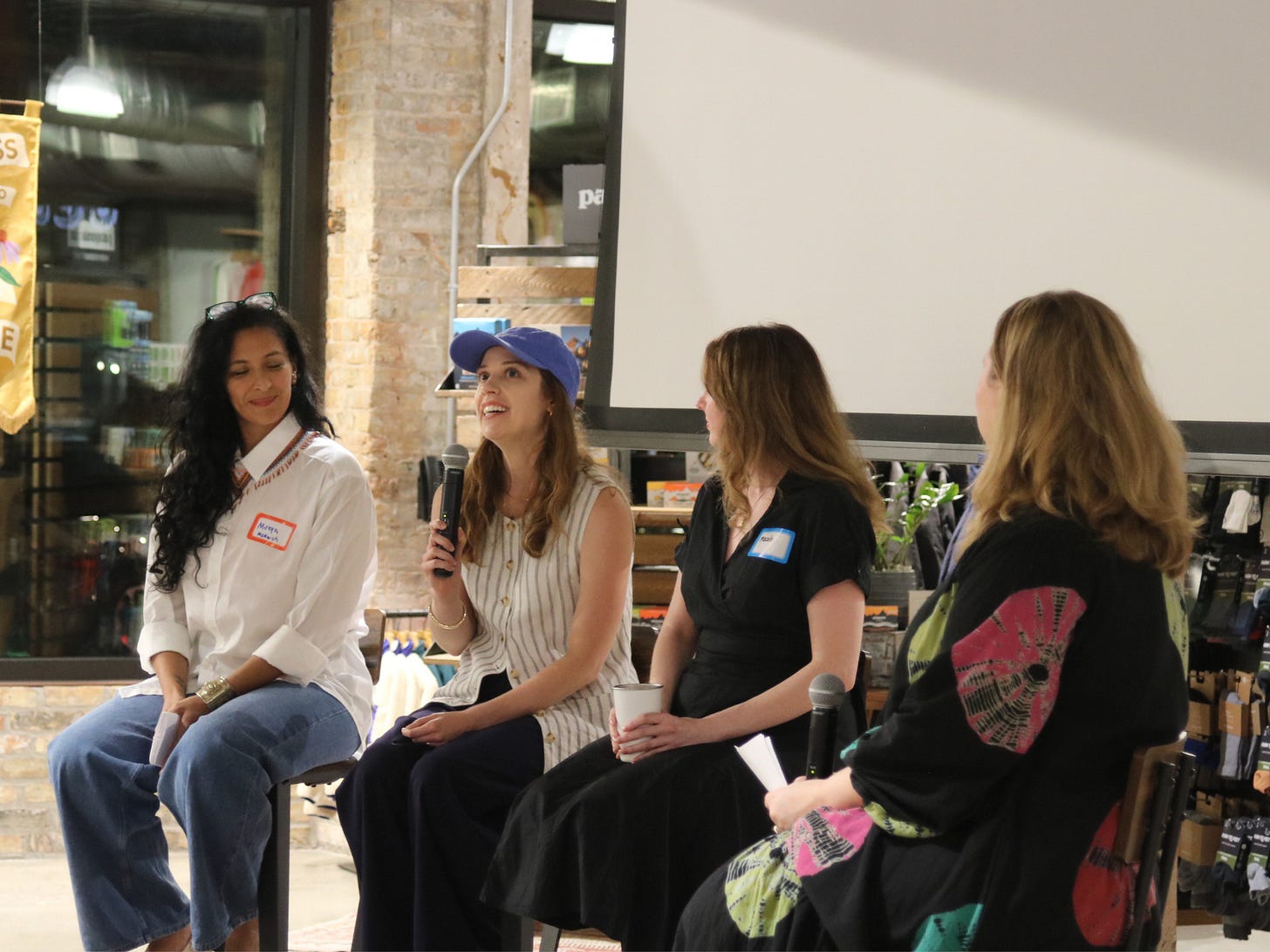
This panel outfit reminded me that style is what we wear to express ourselves, but it’s also a tool to help us navigate our lives. By thinking through these layers of personal style (vibe, shapes, colors, textures, and lifestyle needs) we can balance showing up authentically while honoring the nuances or navigating the constraints of a situation.
For me, that’s the real power of personal style.
One single outfit can’t tell the whole story of who we are. But personal style can be flexible, functional, and expressive of the many sides of our multi-dimensional nature.
So lately, more than asking “does this outfit perfectly express my full self?” I’ve been finding myself asking:
“Does this outfit help me show up in the way I want to? Does it say what I want it to say in this particular moment?“
The post The Many Layers of Personal Style appeared first on .
Green Living
You’re multi-dimensional. So is your style.
Personal style is a dance between dualities: fashion as art and fashion as function; clothing as self-expression and clothing for our circumstances.
Style is a medium for communication and self-expression, yes. But it’s also shaped by the environments and requirements around us, from workplace dress codes to city cultures, climates, and specific occassions.
In last Saturday’s workshop, where we talked about how to remix what you already have in your closet, attendees shared a common challenge:
How do you balance your personal style expression while dressing for the various situations and environments we operate in?
“I’ve found above all else my style is highly influenced by my environment (my job, my city etc.)—sometimes it becomes about ‘fitting in’ and losing individuality”
“I find I’m too led by my day-to-day lifestyle. I WFH and so often I just don’t get dressed at all.”
“There are too many applications: workout, work, at home, formal occasion.”
Style as Identity vs. Style as Communication
It’s no wonder style and getting dressed can feel so confusing.
In the personal style world, we learn to dress for who we are on the inside. And then we see the style rules in fashion media: here’s how to dress for this season, this dress code, this city.
And in our real lives, we have real dress codes we might have to follow, whether for a workplace or a wedding.
But what if all those sides conflict?
- If my style words are “casual” or “sporty” but I’m in a workplace 40+ hours a week that requires business formal, where does that leave my personal style?
- If I love vibrant and artsy looks, but I live in a city full of neutrals, what do I wear?
It’s no surprise it feels… complicated.
Here’s my take.
We’re Not One-Dimensional — Neither is Our Style
Sometimes I want to disconnect and live in cottage in the mountains, surrounded by more trees than people. Other days I dream of having an apartment in the center of Paris where I see more people in a day than live in my hometown.
I’m light, joyful, maybe even quirky with friends. I’m ambitious, intentional, perhaps more serious in work. There are times I feel it’s best to soften and let it go; other times it feels most aligned to be unapologetically outspoken.
We are human. We’re social creatures. We’re complex and full of contradictions.
Social media has trained us to fit people into neat boxes because “niche” is what performs in the algorithm.
In real life, though, our “authentic” selves aren’t so one-dimensional.
I’m not speaking to new networking contacts the same exact way I talk to my best friend I’ve known for years. That doesn’t mean I’m pretending to be someone else. It just means I’m showing up a bit differently depending on the context.
Similarly, our personal style doesn’t have to be expressed in one singular way.
That’s what’s beautiful about fashion! We have the opportunity to express ourselves a bit differently each and every time we get dressed.
What we wear might ebb and flow with a situation, the season, or our mood. There are common threads, but differentiators too.
Three distinctly different looks can all be authentic.
For me, personal style isn’t about being setting such rigid parameters that we can no longer embrace our multi-dimensional nature.
And there’s undoubtedly the layers of privilege at work here too. Is it safe to dress in alignment with your true identity in that particular situation? Will you be taken seriously? Could there be repercussions?
There’s a lot to untangle when it comes to what we wear.
Making Our Multi-Dimensional Style Practical
As I shared in last week’s workshops, style is many layers. The four I see it through are the vibe, the shapes, the colors & textures, and our lifestyle & values.

The aesthetic reflects your vibe, mood or style adjectives.
- For example, my vibe or adjectives are feminine, structured, grounded.
The shapes are the fits, silhouettes, and proportions you love.
- I often wear outfits with a straight silhouette or tailored fit balanced with a relaxed, flowy, or drapey element.
Colors & textures include your preferred palettes, fabrics, and the way materials feel.
- I prefer wearing natural fibers when possible. I like gold jewelry, and I feel more aligned in lower contrast looks. Lighter colors for day. Sometimes darker for evening or certain events.
The lifestyle & values element is the consideration of your actual day-to-day. What situations and environments are you dressing for? What is important to you?
- I work from home so comfort is key most of the time. I value slow fashion practices — rewearing, repairing, and supporting circular practices and sustainably-minded brands.
Once you understand these layers of your style, the next step is figuring out how to apply them in real-life situations.
Applying Your Style to the Situation
In last week’s workshops, I talked about the role of outfit templates here for various situations. What is the foundational blueprint of what you might wear to your office, working from home, in a school setting, at home, running errands, and so on?
There are opportunities to bring in the layers of your personal style in these various situations, but it does require some intentionally on the outset. Otherwise, it’s easy to fall into our old patterns or copy what others around us wear. (Even subconsciously, as fashion psychologist Shakaila Forbes-Bell has shared!)
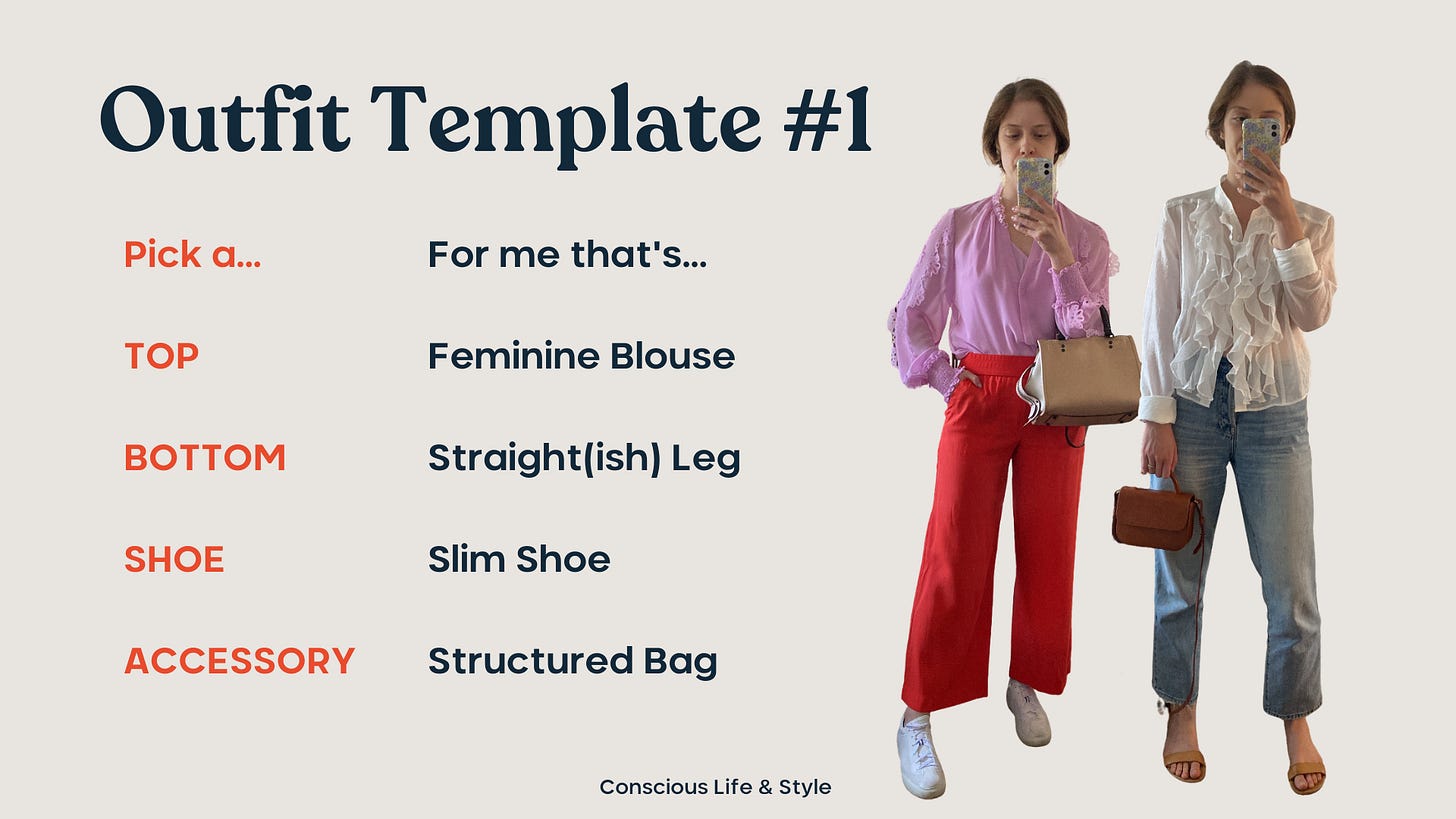
Here’s one of my work-from-home outfit templates that balances style and situational needs:
- Blouse with feminine detail: I start with the top for Zoom calls!
- Straight-leg bottoms: this could be jeans, colorful pants, or a column skirt
- Slim shoes: the general “slim” descriptor makes it versatile across seasons
- Structured bag: an option to add polish when coworking at a café
By thinking in these various layers (vibe, shapes, colors & textures, and lifestyle & values) you can build outfits that feel authentic to you while fitting the constraints of the external situation.
What About One-Off Unique Situations?
Like this Wednesday evening, I spoke on a “Sustainable Fashion in Action” panel with Chicago Climate Connect during Sustainable Fashion Week Chicago. But the panel was also taking place at the Patagonia x Worn Wear store.
So the vibe was professional meets fashion, but also kinda casual?! And we are still in the Midwest here. I have to say, this one wasn’t easy.
But here’s the step-by-step thought process that helped me balance my style, function, and a unique-to-me context.
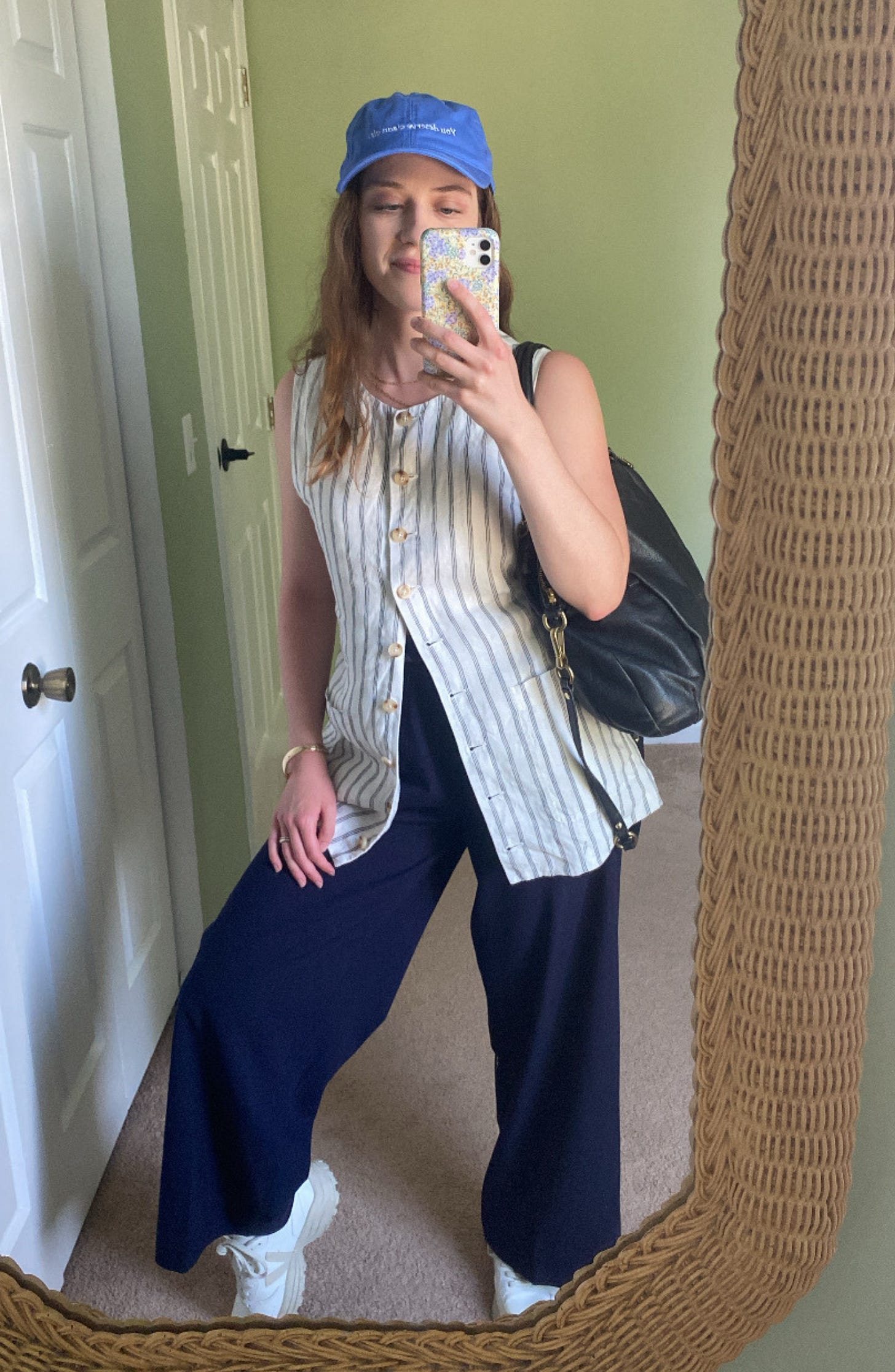
- I picked a foundational piece: My navy wide-leg trousers were business casual without being too formal and were practical for train travel.
- And functional accessories:My old Coach bag fits everything and my chunky Veja sneakers matched the vibe I was going for so those were the picks.
- Then a piece that brought it all together:At this point I was mixing high-contrast colors (white with navy & black) and different vibes (trousers vs. sneakers). I felt like I needed a bridge for the outfit, and this navy-striped vest tied it all together.
- Finally, some final touches: Gold jewelry made the look feel more “me”, while this cap from Abbie at The Filtery made it all feel effortless.
In the end, this outfit took a lot longer to create than a typical look.
It took longer to create than my usual outfits, but it felt just right. The combination was practical, suited my style, fit the vibe of the panel, and aligned with the weather.

This panel outfit reminded me that style is what we wear to express ourselves, but it’s also a tool to help us navigate our lives. By thinking through these layers of personal style (vibe, shapes, colors, textures, and lifestyle needs) we can balance showing up authentically while honoring the nuances or navigating the constraints of a situation.
For me, that’s the real power of personal style.
One single outfit can’t tell the whole story of who we are. But personal style can be flexible, functional, and expressive of the many sides of our multi-dimensional nature.
So lately, more than asking “does this outfit perfectly express my full self?” I’ve been finding myself asking:
“Does this outfit help me show up in the way I want to? Does it say what I want it to say in this particular moment?“
The post You’re multi-dimensional. So is your style. appeared first on .
-
Climate Change2 years ago
Spanish-language misinformation on renewable energy spreads online, report shows
-
Climate Change2 months ago
Guest post: Why China is still building new coal – and when it might stop
-
Climate Change Videos2 years ago
The toxic gas flares fuelling Nigeria’s climate change – BBC News
-

 Greenhouse Gases1 year ago
Greenhouse Gases1 year ago嘉宾来稿:满足中国增长的用电需求 光伏加储能“比新建煤电更实惠”
-
Greenhouse Gases2 months ago
Guest post: Why China is still building new coal – and when it might stop
-

 Climate Change1 year ago
Climate Change1 year ago嘉宾来稿:满足中国增长的用电需求 光伏加储能“比新建煤电更实惠”
-

 Carbon Footprint2 years ago
Carbon Footprint2 years agoUS SEC’s Climate Disclosure Rules Spur Renewed Interest in Carbon Credits
-
Renewable Energy3 months ago
US Grid Strain, Possible Allete Sale




